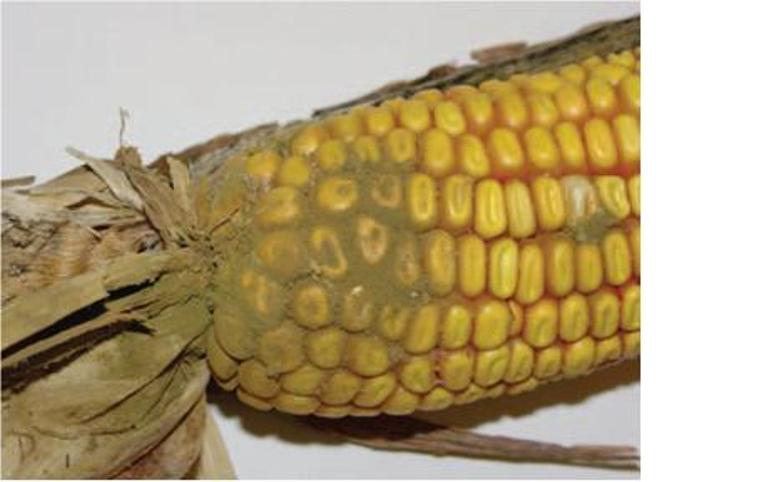Hot, Dry Conditions Can Produce Ear Rot in Corn
Heat and drought in the Corn Belt have created the perfect conditions for Aspergillus ear rot to develop in corn grain and silage – something Purdue Extension plant pathologists say grain and livestock producers need to prepare for.
July 31, 2012

Heat and drought in the Corn Belt have created the perfect conditions for Aspergillus ear rot to develop in corn grain and silage – something Purdue Extension plant pathologists say grain and livestock producers need to prepare for.
The disease is caused by a fungus that produces aflatoxin, a toxic carcinogen for livestock that consume contaminated grain or silage.
Aspergillus ear rot normally shows up near the end of the corn growing season as the crop reaches the dent phase. Growers can identify the disease by peeling back the husks and looking for stunted ears with an olive-green dusty mold.
“This year presents a unique challenge for producers since corn may be cut for silage and many fields have poorly pollinated plants and limited kernel set,” Purdue’s Kiersten Wise says. “Growers have asked questions about assessing the potential for Aspergillus ear rot and aflatoxin to occur in these fields."
The fungus that causes ear rot needs kernels on an ear to develop. Without ears or kernels, Aspergillus ear rot and aflatoxin won't be a problem.
If ears with kernels are present in a field, Wise says it's important to determine if aflatoxin is present. Both corn silage and grain can be submitted for analysis by a professional laboratory, such as Purdue's Animal Disease Diagnostic Laboratory (https://www.addl.purdue.edu/
The U.S. Department of Agriculture has set thresholds for the amount of aflatoxin tolerated in grain, depending on the end use.
“Aflatoxins are of concern to dairy producers in particular because the Food and Drug Administration regulations require aflatoxin residues in milk to be less than 0.5 parts per billion,” he says. “To prevent the carryover of aflatoxins into milk, silage and other feed components should not contain greater than 20 parts per billion.”
Other restrictions are:
* Corn for animal feed or human consumption: 20 parts per billion.
* Corn grain for breeding cattle, swine and mature poultry: 100 parts per billion.
* Corn grain for finishing swine of 100 pounds or more: 200 parts per billion.
* Corn grain for finishing beef cattle: 300 parts per billion.
The bad news for both grain and livestock producers is that at this point in the season there is little they can do to manage Aspergillus ear rot or aflatoxin.
The best they can do now, according to Wise, is scout prior to harvest and determine if there is a problem and, if so, its severity.
“If any Aspergillus ear rot is observed in a field, affected areas should be harvested early and grain segregated to avoid aflatoxin contamination of non-infected grain,” she says. “Grain harvested with suspected Aspergillus ear rot should be dried to below 15% moisture.”
Aflatoxin can continue to accumulate in grain or silage with kernels kept above 15% moisture.
“All grain contaminated by ear rot fungus should be stored separately from good grain and stored below 13% moisture to prevent further growth of fungi,” Wise says.
More information about this disease is available in a free Purdue Extension publication, “Diseases of Corn: Aspergillus Ear Rot,” available at http://www.extension.purdue.edu/extmedia/BP/BP-83-W.pdf
You May Also Like



